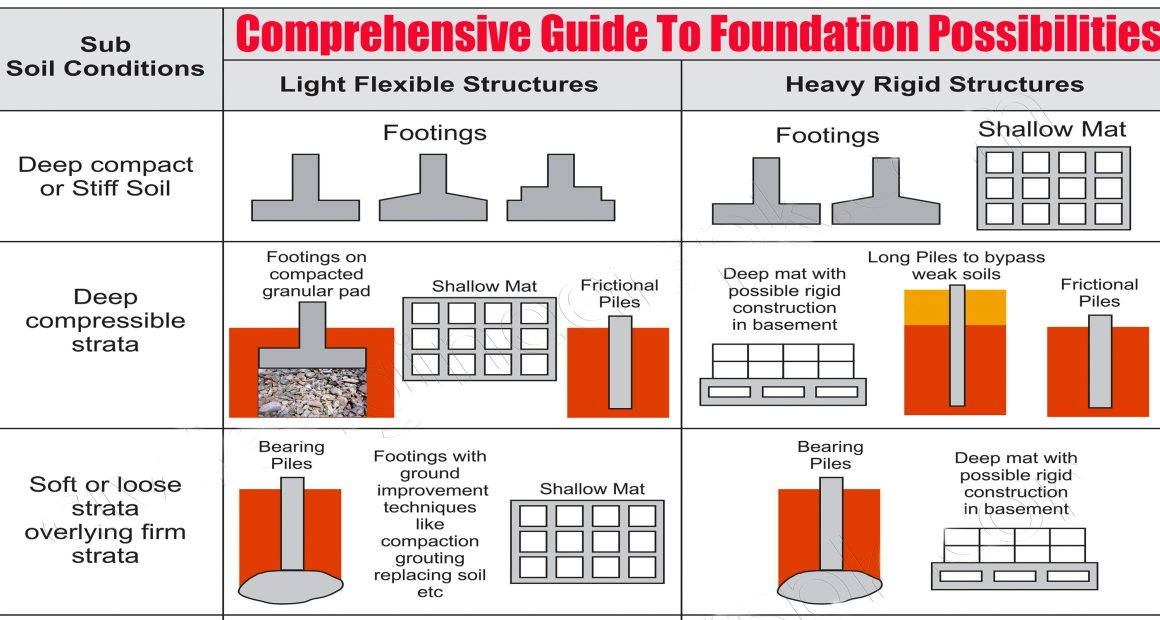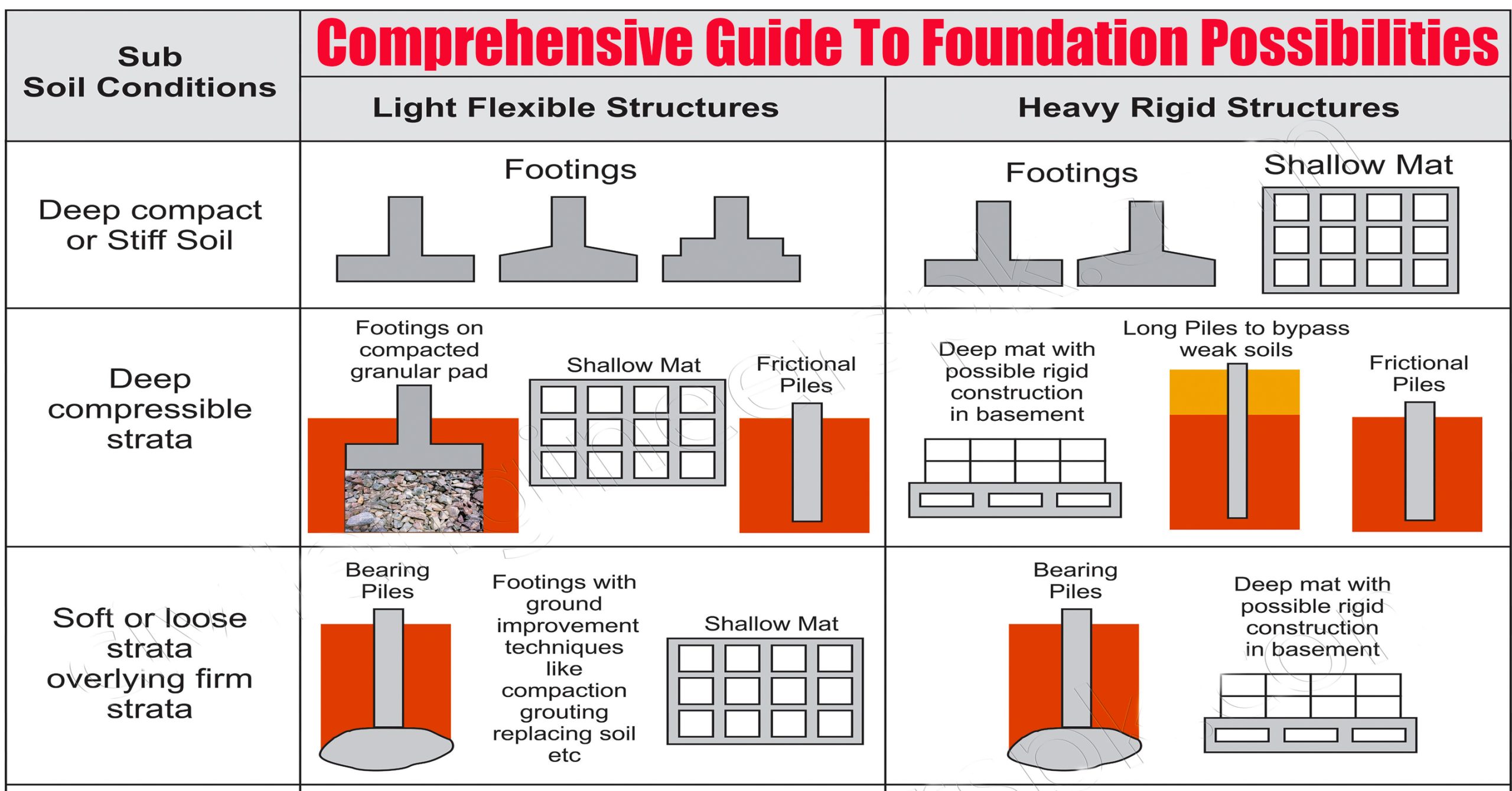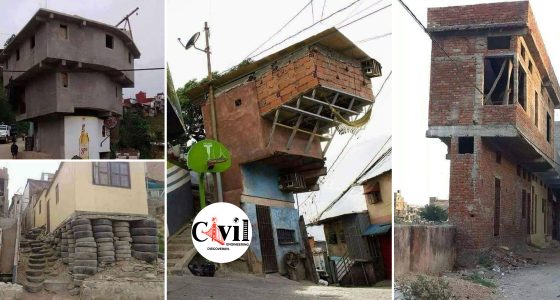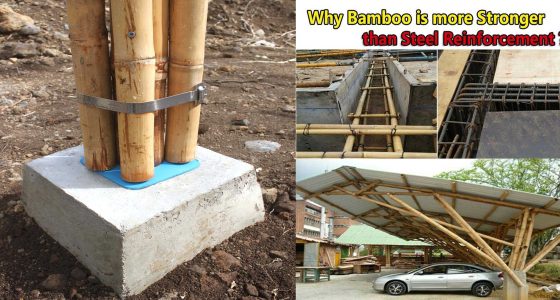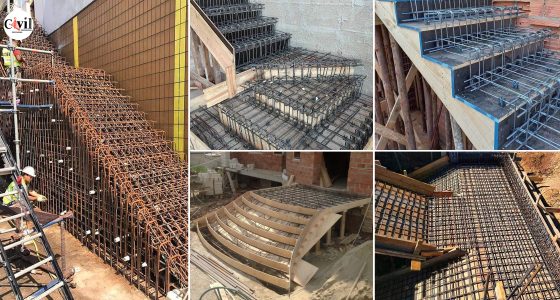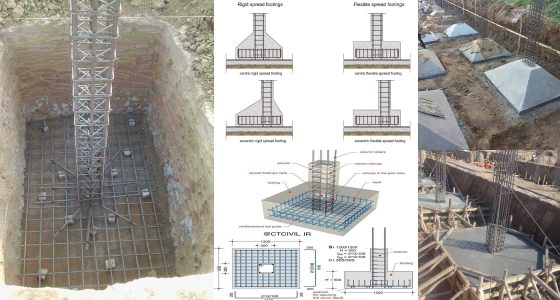Selecting a suitable foundation system is one of the most critical decisions when designing any structure. This choice not only affects the safety and performance of the building but also impacts the overall cost and constructability. The nature of subsoil conditions and the type of structure—light flexible, or heavy rigid—are the key factors influencing foundation selection. Below, we delve deep into various foundation possibilities categorized by subsoil characteristics, drawing comparisons between what is optimal for light, flexible structures and heavy rigid structures.
Deep Compact or Stiff Soil
For Light Flexible Structures
In the presence of deep compact or stiff soils, conventional isolated footings are often adequate. These are cost-effective, easy to construct, and capable of bearing light structural loads without excessive settlement.
For Heavy Rigid Structures
For heavier structures, footings remain suitable, but if loads increase significantly, a shallow mat foundation may be employed. The mat helps in distributing the loads more evenly and ensures structural integrity over a larger area.
Deep Compressible Strata
For Light Flexible Structures
This condition presents more challenges due to the soil’s low load-bearing capacity. Common foundation choices include:
Footings on compacted granular pad – to improve soil properties beneath.
Shallow mat foundations – used where uniform settlements are tolerable.
Frictional piles – used to transfer loads through skin friction along the pile shaft when end-bearing is not possible.
For Heavy Rigid Structures
Heavier structures require advanced techniques such as:
Deep mat foundation with rigid basement construction – helps anchor the structure and minimize settlement.
Long piles to bypass weak compressible strata and reach stable soil layers.
Frictional piles, especially when end-bearing isn’t viable.
Soft or Loose Strata Overlying Firm Strata
For Light Flexible Structures
In these conditions, the goal is to bypass the soft upper layer and transfer loads to the competent stratum below:
Bearing piles – extend to the firm strata for load transfer.
Ground improvement techniques – like soil compaction, grouting, or soil replacement to increase bearing capacity.
Shallow mats – may be viable if adequate ground improvement is done.
For Heavy Rigid Structures
Heavier buildings necessitate more robust solutions:
Bearing piles – provide stability by reaching the strong layer beneath.
Deep mat foundations with rigid basement design – provide stiffness and control differential settlements.
Compact or Stiff Layer Overlying Soft Deposit
For Light Flexible Structures
The challenge here is the unpredictability of settlement due to the soft deposit underneath:
Isolated footings – suitable if the upper compact layer is thick and competent.
Shallow mat foundation – helps distribute loads and reduce differential settlement risks.
For Heavy Rigid Structures
Given the higher loads, advanced systems are necessary:
Deep mat (floating) foundations – designed to “float” over the weaker deposits while distributing loads.
Long piles – bypass the compact upper layer and penetrate the softer deposits to reach a more stable layer.
Alternating Soft and Stiff Layers
For Light Flexible Structures
These varying layers can cause uneven settlement:
Footings and shallow mats are used with caution, and only where soil investigation confirms a safe bearing capacity.
For Heavy Rigid Structures
Complex soil layering demands equally complex solutions:
Deep mat foundations (floating) – effective in spreading structural loads evenly across variable soil profiles.
Piles and caissons – extend to deeper, more reliable soil strata to provide firm anchorage and prevent differential settlement.
Key Factors Influencing Foundation Selection
To ensure structural safety and longevity, several considerations must be taken into account:
Load magnitude and distribution: Heavier structures need deeper, more secure foundations.
Settlement characteristics: Uniform settlement is acceptable; differential settlement must be minimized.
Soil investigation data: Must include bore log details, SPT/N values, groundwater table, etc.
Construction feasibility and cost: Availability of materials, labor, and equipment for pile driving or mat construction.
Popular Foundation Types – At a Glance
| Foundation Type | Best Use Scenario |
|---|---|
| Isolated Footings | Compact/stiff soils with light loads |
| Shallow Mat | Moderate loads with relatively uniform soil |
| Granular Pad Footing | Compressible strata with improvement |
| Frictional Piles | Deep soft soil with no firm bearing stratum |
| Bearing Piles | Soft surface overlying firm strata |
| Floating Mat | Heavy loads over soft deposits |
| Caissons | Large axial and lateral loads, deep foundation |
Expert Recommendations
Always begin with a detailed geotechnical site investigation.
Choose foundation types that balance cost-efficiency with performance.
For heavy structures on poor soils, deep foundations like piles or caissons are typically indispensable.
Where possible, combine shallow foundations with soil improvement techniques for light structures.
Consider the long-term performance and not just initial construction cost when choosing a foundation system.
